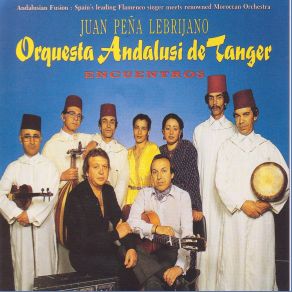Encuentros
Download links and information about Encuentros by Juan Peña " Lebrijano " / Juan Pena " Lebrijano ". This album was released in 1994 and it belongs to World Music genres. It contains 8 tracks with total duration of 35:03 minutes.

|
|
|---|---|
| Artist: | Juan Peña " Lebrijano " / Juan Pena " Lebrijano " |
| Release date: | 1994 |
| Genre: | World Music |
| Tracks: | 8 |
| Duration: | 35:03 |
| Buy it NOW at: | |
| Buy on iTunes $7.92 | |
Tracks
[Edit]| No. | Title | Length |
|---|---|---|
| 1. | Vivir un Cuento de Hadas | 5:10 |
| 2. | Dame la Libertad | 4:05 |
| 3. | Las Mil y una Noches | 4:28 |
| 4. | Desafío | 4:05 |
| 5. | El Anillo | 4:48 |
| 6. | Pensamientos | 3:01 |
| 7. | Amigo Mio, No | 4:41 |
| 8. | Esos Ojos Asesinos | 4:45 |
Details
[Edit]Encuentros (encounters or collisions) is the first collaboration between the Gypsy flamenco singer Juan Pena Lebrijano (known as "El Lebrijano" because his family hails from Lebrija, Spain) and an Andalusian orchestra from Morocco. With the musical direction and flamenco guitar of Paco Cepero tying it together, the songwriting team of poet and lyricist Caballero Bonald, P. Rivera, and El Lebrijano craft some wonderful mixes of the two heritages. The album has sold over 200,000 copies. The liner notes are skimpy and give no particulars about the Moroccan orchestra. The ensemble consists of Western strings (featuring a violin played Moroccan style), Arabic percussion, a few Arabic instruments like the quanun, a kind of hammer dulcimer, chorus, and solo voices. In general, the strings and chorus provide a dramatic backdrop and commentary to the interplay between El Lebrijano and the Moroccan singers, on the one hand, and the flamenco guitar and the violin and quanun, on the other. The words are in both Spanish and Arabic and tell of love, freedom, and murder. The album is raw, passionate, and engaging, but not without flaws. It clocks in at 35:07, a disgracefully short time in the era of CDs. The recording quality is less than polished — for example, the percussion is too prominent in the mix and some of the Arabic instruments are inaudible at times. And of course, it is criminal that the Moroccan artists receive no credit by name whatsoever. Still, a vital album for anyone interested in either of the two traditions that so fruitfully collide here.